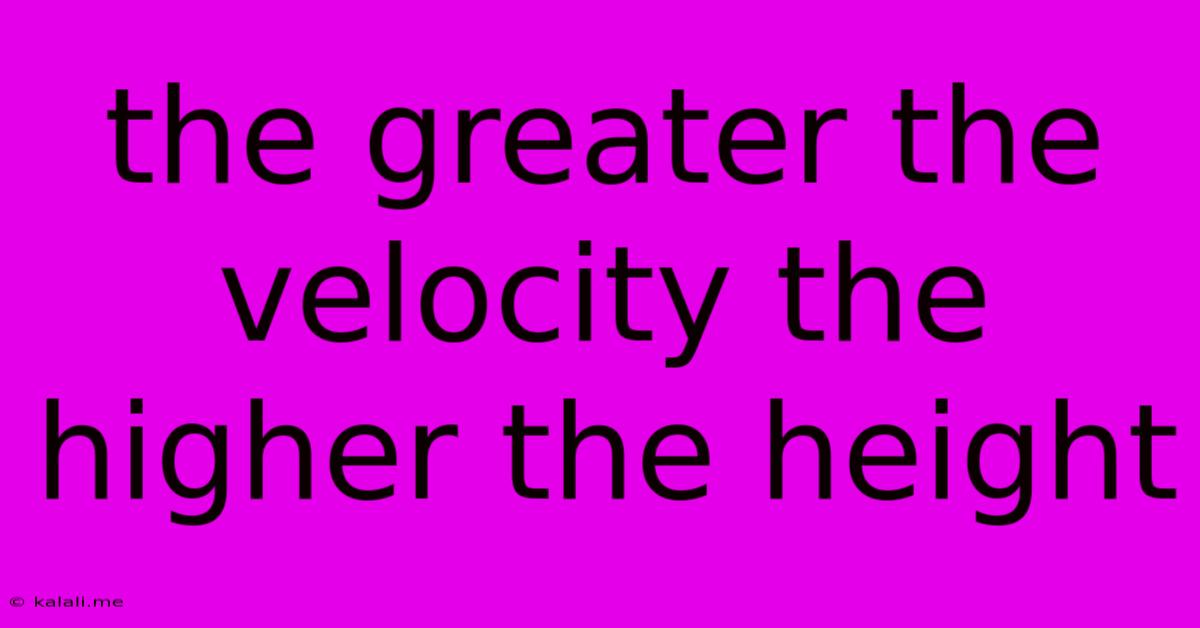The Greater The Velocity The Higher The Height
Kalali
Jun 07, 2025 · 3 min read

Table of Contents
The Greater the Velocity, the Higher the Height: Understanding Projectile Motion
This article explores the relationship between initial velocity and the maximum height achieved by a projectile, a fundamental concept in physics. We'll delve into the mechanics behind this principle, examining the role of gravity and other factors influencing projectile trajectory. Understanding this relationship is crucial in fields ranging from sports science to aerospace engineering.
Understanding Projectile Motion:
Projectile motion is the curved path followed by an object launched into the air, subject only to the force of gravity (neglecting air resistance for simplicity). The object's trajectory depends on two key factors: its initial velocity (speed and direction) and the angle of projection. While the angle plays a significant role in determining range (horizontal distance), initial velocity directly impacts the maximum height reached.
The Role of Initial Velocity:
The greater the initial upward velocity, the higher the projectile will travel. This is because a higher velocity provides greater initial kinetic energy. This kinetic energy is then converted into potential energy as the projectile rises against gravity. Potential energy is the energy stored by an object due to its position relative to a gravitational field.
The Physics Behind It:
The relationship can be described using basic kinematic equations. The maximum height (h) reached by a projectile launched vertically upwards with initial velocity (v₀) can be calculated using the following equation:
h = v₀²/2g
where:
- h = maximum height
- v₀ = initial vertical velocity
- g = acceleration due to gravity (approximately 9.8 m/s² on Earth)
This equation clearly demonstrates the direct proportionality between the square of the initial velocity and the maximum height. Doubling the initial velocity will quadruple the maximum height.
Factors Influencing Height (Beyond Initial Velocity):
While initial velocity is the primary determinant, other factors can influence the maximum height:
- Angle of Projection: A launch angle of 90 degrees (straight upwards) results in the maximum height for a given initial velocity. Any other angle will result in a lower maximum height.
- Air Resistance: In real-world scenarios, air resistance opposes the motion of the projectile, reducing its maximum height. This effect is more significant for lighter, less aerodynamic objects.
- Gravity: The strength of gravity influences the rate at which the projectile loses vertical velocity. On planets with stronger gravity, the maximum height will be lower.
Practical Applications:
The principle of higher velocity leading to greater height is evident in many areas:
- Sports: In sports like basketball, volleyball, and long jump, athletes maximize their vertical leap by generating high initial velocities in their jumps.
- Rocketry: The launch velocity of a rocket is critical for achieving a desired altitude.
- Ballistics: Understanding projectile motion is crucial in fields like ballistics and military applications for accurate targeting.
Conclusion:
The relationship between initial velocity and maximum height in projectile motion is fundamental to understanding the behavior of objects launched into the air. While the initial vertical velocity is the primary factor, other factors like the angle of projection and air resistance play secondary roles. This principle is applicable across various fields, highlighting its practical significance in understanding and predicting projectile trajectories.
Latest Posts
Latest Posts
-
Can I Replac Ea Porch Nail With A Along Screw
Jun 07, 2025
-
Wire For A 200 Amp Service
Jun 07, 2025
-
Different Kinds Of Objects That Change
Jun 07, 2025
-
Why Does My Dog Lick Her Paws
Jun 07, 2025
-
Could You Do Me A Solid
Jun 07, 2025
Related Post
Thank you for visiting our website which covers about The Greater The Velocity The Higher The Height . We hope the information provided has been useful to you. Feel free to contact us if you have any questions or need further assistance. See you next time and don't miss to bookmark.